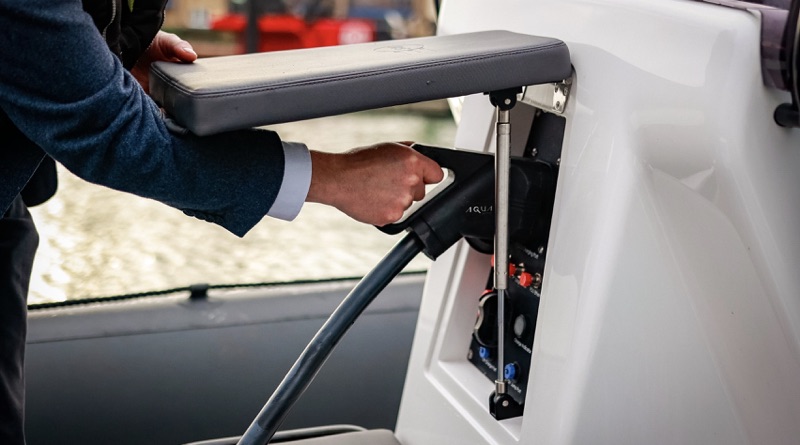Aqua superPower leading vessel-to-grid ‘virtual bunkering’ demo
Global marine charging network Aqua superPower is spearheading the UK’s Virtual Bunkering for Electric Vessels (VBEV) demonstration of vessel-to-grid bi-directional charging capabilities.
The essence of the project – and the VBEV concept – is that electrons don’t care where they are stored or used, so the battery of an electric boat can send electricity back to a mainland grid just as easily as the grid can send electricity to the boat.
This push and pull arrangement treats the e-boat battery as a system of back up storage cells that can be drawn from to supply energy for houses, offices, factories or anything else connected to an energy utility’s network.
It is a growing trend in the electric vehicle world, where the bi-direction Vehicle-to-Grid integration is known as ‘V2G’ – which seems equally appropriate for a Vessel-to-Grid set up like the VBEV demonstration.
Vessel-to-Grid a ‘win-win-win’ proposition
Ed. Note: The ‘Virtual Bunkering’ in VBEV is a reference to the term ‘bunkering’ of fossil fuel. Ships use bunker fuel and bunkering is the logistics of loading and distributing it among available shipboard tanks. With electricity there is no physical fuel, hence ‘virtual bunkering’.
The reason V2G is an attractive proposition is that it is a ‘win-win-win’ proposition for the vessel owner, the utility or grid operator, and the public.
Read: Evoy electric boat motor company working on V2G program in Canada
The vessel owner can reduce costs by selling electricity back to the grid, the utility reduces the amount of electrical generation it needs – and because a significant amount of generation still comes from burning fossil fuels – the public wins with reduced carbon emissions.
There is also another winner – the owner of the port or marina where the boat is moored. The VBEV will test two pivotal scenarios: vessel-to-grid, where the energy is exported to the entire electricity network, and a ‘behind-the-meter’ that transfers the electricity between the boats and the marina/port/harbour to enhance on-site energy management.

CEO Alex Bamberg of Aqua superPower who is leading the VBEV project, says “Enhanced energy management will allow sites to better adapt to increasing demands on power from electrification of vessels, potentially reduce the grid connection where capacity is limited or costly and integrate more renewables.”
The VBEV project is the result of a successful entry in the UK’s Clean Maritime Demonstration Competition that allocated research and development funding to support the design and development of zero emission shipping technologies and greener ports.
The program started in 2021 and the VBEV has been successful in the the four rounds of competition thus far and will now demonstrate the real life potential to significantly slash carbon emissions on both a system and site level, propelling the maritime industry towards a cleaner and more sustainable future.

In addition to Aqua superPower, the consortium participating in the project includes two electric boat manufacturers: RS Electric and Ingenity; energy company EDF; the University of Plymouth; City College of Plymouth; Research Centre CENEX, and bi-directional software provider Fuuse Ltd.
Working together they will leverage the opportunity presented by the electrification of vessels and highlight how the benefits of electric boats can be optimized, particularly in the recreational and workboat sectors that RS Electric and Ingenity operate in.
Electric boats upgrading to 2-way charging software
Two boats will be connected to bi-directional (two way) chargers, that will enable, monitor and manage the energy being sent to the grid and behind the meter. The 4 week demonstrator is designed to illustrate how all key infrastructure, software, vessel, and energy components interact.
To do all this requires software upgrades, communication protocol adoption, and latest iteration of charge controllers for the electric boats. The goal is seamless communication between batteries and bi-directional chargers, laying the foundation for a vessel-to-grid management platform that makes the most of charge and discharge scheduling and maximizes energy efficiency.
The importance of testing and developing the bi-directional software and the interaction of electric boat batteries with the larger grid is hugely significant for reducing carbon emissions from the marine sector.
Not a boat with a battery, a battery with a boat
It is key to developing and promoting the idea that electric propulsion should not be considered a boat with a battery attached, but rather a battery with a boat attached. For the recreational sector in particular, where hours of boat use is necessarily low, the battery can still contribute to the reduction of carbon emissions when the boat is at the dock by reducing the grid’s reliance on electricity generation.
According to British Marine, the UK has over a quarter of a million recreational/commercial vessels under 12m (40 ft) with another 10,000 boats joining the fleet every year. The country is getting ready to transition to zero-emission operations over the next decade and this presents a massive electrification opportunity.

With the electric vessel industry on the rise, this initiative promises a scalable future with benefits ranging from improved battery health to reduced operational costs and revenue generation. VBEV will produce the first vessels capable of bi-directional power transfer, set a standard for other vessel manufacturers, develop a vessel-to-grid management platform, provide world leading research and development of a commercial product for customers.
Jon Partridge, CEO of RS Marine Group and RS Electric Boats, said “We are thrilled to participate in these trials and firmly believe V2G innovation will significantly reduce ownership costs and lower the barriers to zero-emission transition. Importantly, our Pulse 63 will set a precedent as the first production electric boat equipped with V2G capabilities.”
Capt. Todd Sims, Business Development Director for Ingenity, agreed. “We have customers with boats around the world and look forward to being able to offer this additional benefit of electric boat ownership sometime very soon.”
Aqua superPower RS Electric Boats Ingenity
RS Electric Boats in the Plugboats Marketplace Ingenity boats in the Plugboats Marketplace


